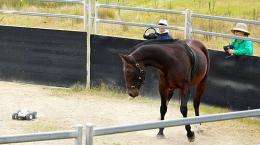Researchers urge rethink of 'Monty Roberts' horse training method

(Phys.org) -- Aspects of a horse training method made famous by Monty Roberts, author of the The Man Who Listens to Horses, have been called into question by research at the University of Sydney.
"This training technique was popularised worldwide by Roberts as the Join-Up method and was used by him to train Queen Elizabeth's horses at her personal request," said Cath Henshall, a Master of Animal Science candidate in the Faculty of Veterinary Science at the University. Henshall led the research and is presenting her findings at the International Society for Equitation Science conference in Edinburgh on 17 July.
"Two main features of the method, also known as round pen horse training, are that it depends on the human trainer being able to communicate with the horse using 'horse' body language, and that it is a humane form of training. Our study casts doubt on both those claims.
"We believe that our research highlights the unpleasant underpinnings of round pen horse training and for that reason we caution against its widespread use because it uses fear to gain control of horses."
As currently practised the technique relies on the trainer using movement and noise to drive the horse around the perimeter of the pen. The trainer gradually reduces their aggressive movements, after which the horse will eventually slow down and approach them.
The researchers used remote control cars to mimic the technique and to eliminate the assumed essential role of the humans speaking the language of the horse.
"We 'rewarded' the horses for stopping and turning towards the car with a period of 'safety', when the car didn't chase them as long as they kept facing it. We trained some horses to actually walk up to and touch the car," said Henshall.
"Given that we could train horses to produce similar, though not identical responses to those seen in round pen training, but in reaction to non-human stimuli undermines the claim that the human's ability to mimic horse behaviour is an essential component of the technique."
The researchers believe that the training outcomes were achieved as a result of 'pressure-release' and not the ability of the trainer, or a remote control car, to mimic horse behavior.
"Put simply, pressure-release works because the horse finds the pressure applied unpleasant and therefore the removal of the pressure rewarding," said Henshall.
The response the horse makes immediately before the pressure is removed is what the horse thinks made the pressure go away. When put in the same situation in the future, it is likely to perform that same behaviour to obtain the outcome that it values - safety.
"Although neither Monty Roberts' method nor ours uses pressure applied directly to the horse's body, both apply a form of emotional pressure by scaring and then chasing the horse."
Proponents of Join-Up and similar methods claim not only that they are humane because no equipment is used on the horse's body but also that the horse can choose whether to approach the trainer.
"Our results indicate that because these methods rely on fear and safety, the horse is forced to choose between being repeatedly frightened or remaining with the trainer. We question whether it is humane to rely on fear and its termination to train horses," said Henshall.
"Although it is appealing to think that horses in the round pen choose to follow their trainers because they are responding to us as though we are a horse, we believe that the use of fear has no place in genuinely humane and ethical horse training."
Provided by University of Sydney



















